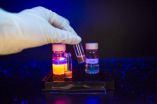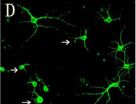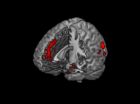(Press-News.org) Putnam Valley, NY. (Mar. 28 2014) – New insight has been gained into treating an inherited disorder that creates serious neurological and behavioral disabilities in children and usually leads to death in the teen years.
In a recent study into the effects of human umbilical cord blood mononuclear cells (hUCB MNCs) when they are injected to counter the symptoms and progression of Sanfilippo syndrome type III B (MPS III B), researchers found that repeated injections into laboratory mice modeled with the disorder had clear benefits for the mice receiving multiple injections over control groups that received single injections of either a high or low dose of cells.
The study will be published in a future issue of Cell Transplantation but is currently freely available on-line as an unedited early e-pub at: http://www.ingentaconnect.com/content/cog/ct/pre-prints/content-ct1121willing.
MPS III B results from a genetically programmed deficit of the Naglu enzyme. The deficit creates a build-up of heparan sulfate - a complex carbohydrate - that accumulates in lysosomes, cells that are responsible for waste disposal. With MPS III B, accumulations of heparin sulfate in the tissues are not eliminated and the accumulation causes damage to multiple organs, including the brain.
"Cell therapy has recently received attention as a potential treatment for lysosomal storage diseases," said study lead author Dr. Allison E. Willing, of the Center of Excellence for Aging and Brain Repair in the Morsani College of Medicine at the University of South Florida. "We have previously shown that a single hUCB injection into the cerebral ventricle of pre-symptomatic mice, or intravenous cell delivery at different disease stages, had a beneficial effect on the enzyme deficient mice. In the current study, we examined whether administering repeated doses of hUCB MNCs would have a greater effect than a single dose and help to prevent progressive neurodegeneration."
Using three groups of mice modeled with Naglu deficiency by knocking out the Naglu enzyme, the researchers injected one group with repeated doses of hUCB MNCs over a six month period. They administered single doses - either high or low doses - to two other groups of similarly modeled mice. The group that had repeated hUCB MNC doses demonstrated a variety of favorable benefits.
To determine the benefits of repeated hUCB MNC injections, the researchers measured several behavioral and clinical outcomes before and after six months of treatment. These included anxiety, levels of heparin sulfate accumulation, and subsequent pathology in various anatomical brain locations.
"Repeated injections of hUCB MNCs produced the greatest neuroprotection," stated study co-lead author Dr. Svitlana Garbuzova-Davis, of the Center of Excellence for Aging and Brain Repair in the Morsani College of Medicine at the University of South Florida. "Hippocampal structural architecture remained intact in the repeated dose-treated mice as compared to the other groups. Also, there was restoration of the dendritic tree in the group receiving repeated doses. We also saw a striking reduction in microgliosis and microglial activation after hUCB MNC treatment."
The researchers speculated that administering hUCB MNCs may decrease neuropathy through modulation of inflammatory and immune processes as the hUCB MNCs produced numerous neurotrophic and growth factors.
"We demonstrated that hUCB MNCs were particularly effective at modulating anxiety in the Naglu knockout mice,"concluded Paul R. Sanberg, distinguished professor at USF and principal investigator of the Children's Medical Research Foundation funded project. "Our results suggest that repeated administrations of hUCB MNCs produce greater amelioration of the underlying disease pathology. However, further studies will be necessary to determine if this treatment regimen can slow the progression of the disease, increase survival while minimizing symptoms, and determine whether improved outcomes are a function of enzyme administration, decreased inflammation, or both."
"This study highlights the benefits of using multiple injections rather than a single injection to treat Sanfilippo syndrome type III B" said Dr. John Sladek, Cell Transplantation section editor and professor of neurology and pediatrics at the University of Colorado School of Medicine. "This use of multiple treatments may be applicable to other neurodegenerative disorders, as already suggested by animal studies published by the same group for the treatment of amyotrophic lateral sclerosis."
INFORMATION:
Disclosure: AEW, SGD and PRS serve as consultants and founder, respectively, of Saneron CCEL Therapeutics, Inc., which provided the cord blood.
Contact:
Dr. Alison E. WillingCenter of Excellence for Aging and Brain Repair Morsani College of MedicineUniversity of South Florida 12901 Bruce B Downs Blvd MDC78 Tampa, FL 33612
Email: awilling@health.usf.edu
Ph: 813-974-7812
Fax: 813-974-3078
Citation: Willing, A. E.; Garbuzova-Davis, S. N.; Zayko, O.; Derasari, H. M.; Rawls, A. E.; James, C. R.; Mervis, R. F.; Sanberg, C. D.; Kuzmin-Nichols, N.; Sanberg, P. R. Repeated Administrations of Human Umbilical Cord Blood Cells Improve Disease Outcomes in a Mouse Model of Sanfilippo Syndrome Type III B. Cell Transplant. Appeared or available online: December 30, 2013
The Coeditors-in-chief for CELL TRANSPLANTATION are at the Diabetes Research Institute, University of Miami Miller School of Medicine and Center for Neuropsychiatry, China Medical University Hospital, TaiChung, Taiwan. Contact, Camillo Ricordi, MD at ricordi@miami.edu or Shinn-Zong Lin, MD, PhD at shinnzong@yahoo.com.tw or David Eve, PhD at celltransplantation@gmail.com
News release by Florida Science Communications http://www.sciencescribe.net
Repeated hUCB injections may improve prognosis of children with deadly inherited disorder
2014-03-28
ELSE PRESS RELEASES FROM THIS DATE:
Rainbow-catching waveguide could revolutionize energy technologies
2014-03-28
BUFFALO, N.Y. – More efficient photovoltaic cells. Improved radar and stealth technology. A new way to recycle waste heat generated by machines into energy.
All may be possible due to breakthrough photonics research at the University at Buffalo.
The work, published March 28 in the journal Scientific Reports, explores the use of a nanoscale microchip component called a "multilayered waveguide taper array" that improves the chip's ability to trap and absorb light.
Unlike current chips, the waveguide tapers (the thimble-shaped structures above) slow and ultimately absorb ...
Gene may predict if further cancer treatments are needed
2014-03-28
DALLAS – March 28, 2014 – UT Southwestern Medical Center researchers are developing a new predictive tool that could help patients with breast cancer and certain lung cancers decide whether follow-up treatments are likely to help.
Dr. Jerry Shay, Vice Chairman and Professor of Cell Biology at UT Southwestern, led a three-year study on the effects of irradiation in a lung cancer-susceptible mouse model. When his team looked at gene expression changes in the mice, then applied them to humans with early stage cancer, the results revealed a breakdown of which patients have ...
Erectile dysfunction can be reversed without medication
2014-03-28
Men suffering from sexual dysfunction can be successful at reversing their problem, by focusing on lifestyle factors and not just relying on medication, according to research at the University of Adelaide.
In a new paper published in the Journal of Sexual Medicine, researchers highlight the incidence of erectile dysfunction and lack of sexual desire among Australian men aged 35-80 years.
Over a five-year period, 31% of the 810 men involved in the study developed some form of erectile dysfunction.
"Sexual relations are not only an important part of people's wellbeing. ...
NUS researchers developed world's first fluorescent sensor to detect date rape drug
2014-03-28
A team of researchers from the National University of Singapore (NUS) has developed the world's first fluorescent sensor to identify the presence of a drug known as GHB that is commonly used to spike beverages. When the sensor is mixed with a sample of a beverage containing GHB, the mixture changes colour in less than 30 seconds, making detection of the drug fast and easy.
This simple mix-and-see discovery, led by Professor Chang Young-Tae of the Department of Chemistry at the NUS Faculty of Science, is a novel scientific breakthrough that contributes towards prevention ...
More male fish 'feminized' by pollution on the Basque coast
2014-03-28
The UPV/EHU's Cell Biology in Environmental Toxicology group has conducted research using thick-lipped grey mullet and has analysed specimens in six zones: Arriluze and Gernika in 2007 and 2008, and since then, Santurtzi, Plentzia, Ondarroa, Deba and Pasaia. The acquisition of feminine features by male fish has been detected, to a greater or lesser extent, in all the estuaries, not only in the characteristics of the gonads of the specimens analysed but also in various molecular markers. According to Miren P. Cajaraville, director of the research group, the results show ...
Fingerprint of dissolved glycine in the Terahertz range explained
2014-03-28
Chemists at the Ruhr-Universität Bochum (RUB) have, for the first time, completely analysed the fingerprint region of the Terahertz spectrum of a biologically relevant molecule in water, in this case, an amino acid. By combining spectroscopy and molecular-dynamics simulations, they rendered the motion of the most basic amino acid, glycine, visible in an aqueous solution. Their results have disproved the long-standing theory that frequencies in the Terahertz range provide no information regarding the amino acid's motion. The team led by Prof Dr Martina Havenith-Newen and ...
Aspartic acid in the hippocampus: A biomarker for postoperative cognitive dysfunction
2014-03-28
Postoperative cognitive dysfunction is the deterioration of cognitive performance after anesthesia and surgery, and manifests as impairments in short-term memory, concentration, language comprehension, and social integration skills. Previous studies have shown that the occurrence of postoperative cognitive dysfunction is affected by many factors, including advanced age, low educational level, pre-existing cognitive impairment, alcohol abuse, and severity of coexisting illness. However, the real cause for postoperative cognitive dysfunction is still unclear. Metabolite changes ...
Ancient African cattle first domesticated in Middle East, MU study reveals
2014-03-28
COLUMBIA, Mo. – Geneticist and anthropologists previously suspected that ancient Africans domesticated cattle native to the African continent nearly 10,000 years ago. Now, a team of University of Missouri researchers has completed the genetic history of 134 cattle breeds from around the world. In the process of completing this history, they found that ancient domesticated African cattle originated in the "Fertile Crescent," a region that covered modern day Iraq, Jordan, Syria and Israel.
Lead researcher Jared Decker, an assistant professor of animal science in the MU ...
Religion, spirituality influence health in different but complementary ways
2014-03-28
CORVALLIS, Ore. – Religion and spirituality have distinct but complementary influences on health, new research from Oregon State University indicates.
"Religion helps regulate behavior and health habits, while spirituality regulates your emotions, how you feel," said Carolyn Aldwin, a gerontology professor in the College of Public Health and Human Sciences at OSU.
Aldwin and colleagues have been working to understand and distinguish the beneficial connections between health, religion and spirituality. The result is a new theoretical model that defines two distinct pathways. ...
Brain scans link concern for justice with reason, not emotion
2014-03-28
People who care about justice are swayed more by reason than emotion, according to new brain scan research from the University of Chicago Department of Psychology and Center for Cognitive and Social Neuroscience.
Psychologists have found that some individuals react more strongly than others to situations that invoke a sense of justice—for example, seeing a person being treated unfairly or mercifully. The new study used brain scans to analyze the thought processes of people with high "justice sensitivity."
"We were interested to examine how individual differences about ...





